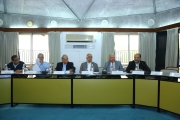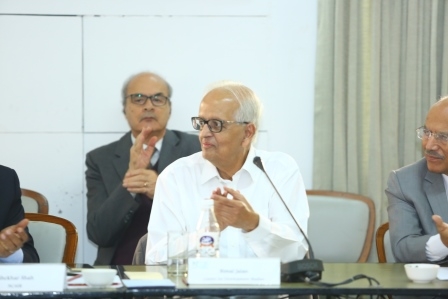In a long standing partnership with the India International Centre, NCAER released its 2017-18 Mid-year Review (MYR) of the Indian Economy. The MYR presents the most comprehensive, independent assessment of the Indian economy. Dr Shekhar Shah opened the seminar with his welcome note, followed by Air Marshal (Retd.) Naresh Verma, Director, IIC. Dr Bimal Jalan, Former President NCAER and Chairman, Centre for Development Studies, who was invited to chair the Review, gave the opening remarks.
Dr Bornali Bhandari, Fellow, NCAER presented the main findings of the Review. Besides a stocktaking of the economy’s performance, NCAER has expanded the focus of the Review over the years to include detailed discussions on key policy issues. In addition, Drs Soumya Bhadury and Sanjib Pohit presented the yet developing NCAER Nowcasting Model, which captures the movements of an economy on a dynamic basis. The Review included two presentations; one on ‘GST Reform: Some Design Issues’ by Dr Pinaki Chakraborty, Professor, NIPFP and the second one on ‘Some Select Issues in the Financial Markets’ by Mr Tushar Arora, Senior Economist, Treasury, HDFC Bank .
Key highlights of the NCAER’s 2017-18 Mid-Year Review of the Indian Economy are as follows:
NCAER forecasts growth of 6.2 per cent for 2017–18 for both GVA (Gross Value Added) at basic prices and Gross Domestic Product (GDP) at market prices. These forecasts at constant (2011–12) prices are based on NCAER’s annual GDP macro model. Real agriculture GVA is forecast to grow at 3.0 per cent, real industry GVA at 4.5 per cent, and real services GVA at 7.6 per cent in 2017–18. The Wholesale Price Index (WPI) inflation is projected at 6.7 per cent for 2017–18. The growth rates in exports and imports, in dollar terms, are estimated at 10.7 per cent and 24.4 per cent, respectively, in 2017–18. The current account balance and central fiscal deficit, as percentages of GDP, are projected at –2.5 per cent and 3.4 per cent, respectively, for 2017–18. These estimates have been revised upwards from August 2017.
With the southwest monsoon being close to its normal distribution, and achieving satisfactory spatial and temporal distribution as compared to last year, the current year is expected to be a year of normal growth for the agricultural sector. The estimated output of kharif rice is expected to witness an increase of 2.1 per cent to 3.3 per cent due to a combination of good rainfall and its somewhat better distribution in the rice-growing regions. However, the output of kharif coarse cereals and pulses is likely to drop due to higher output being achieved last year and somewhat poor distribution of the monsoon rainfall in areas where these crops are cultivated. The output of kharif oilseeds has been estimated to remain at the same level as that of last year due to the below par performance of the monsoon rainfall in the main oilseed-growing regions. In the case of cotton, NCAER estimates suggest a marginal growth of 1.5 to 3.4 per cent over the preceding year’s output of 32.3 million bales. The projected output of sugarcane is also likely to be close to last year’s level of output. The current year’s storage, as on November 2, 2017, was 96 per cent of the live storage of the corresponding period last year and 96 per cent of the average storage of the last ten years. This augurs well for the current year’s rabi season.
As regards the industrial sector, the Index of Industrial Production (IIP) showed a year-on-year (y-o-y) growth of 2.2 per cent during the period April–August, 2017 versus 5.9 per cent during the corresponding period in 2016. The manufacturing IIP showed the most significant slowdown with 1.6 per cent growth in April–August 2017 versus 6.1 per cent in the corresponding period last year. The steep decline from 9.6 per cent in April–August 2016 to (–) 1.9 per cent in the corresponding period in 2017 in the capital goods sector reflects the low investment scenario in the economy. The intermediate and infrastructure sectors too noted a sizeable decline in their respective growth rates. As regards the consumer goods sector, the consumer durable segment experienced a steep decline from 6.2 per cent to (–) 0.9 per cent during this period. The core infrastructure industries registered a growth of 3.3 per cent during 2017–18: H1 as against 5.4 per cent recorded during the corresponding period of the previous year. Specifically, fertilisers and cement show a steep fall in the y-o-y growth rate in 2017–18: H1 as compared to 2016–17, consequently slipping into negative territory. Although crude oil production showed an improvement, its y-o-y growth rate in 2017–18: H1 was still negative at –0.2 per cent as compared to –3.3 per cent recorded during the corresponding period of the previous fiscal. However, both the Nikkei PMI Index and the SBI Composite Index showed renewed weakness in October 2017 after exhibiting signs of recovery in September 2017. Meanwhile, the Indian industrial sector is on a shaky recovery path due to the implementation challenges of the Goods and Services Tax and uneven demand. With greater emphasis on improving ease of doing business, attracting foreign inflows, recapitalising public sector banks and efforts to achieve continuous improvements on the GST front, the Indian industrial sector hopes to overcome its transition blues in 2018–19.
The first quarter of the current fiscal witnessed strong growth in two major services sectors including trade, hotels, transport, communication and services related to broadcasting; and financial, real estate and professional services. The lead indicators from the services sectors indicate a mixed outlook. While the aviation sector continues to exhibit a strong growth momentum, tourist arrivals, and revenue earning goods traffic are the other segments showing higher growth in the first half of the current fiscal as compared to the previous one. International cargo traffic, which accounts for 64.5 per cent of the total cargo traffic, notably exhibited a y-o-y growth of 19.2 per cent in during April–August 2017 as compared to 8.1 per cent achieved during the corresponding period in the previous fiscal. While the impact of the GST on the services sector is uncertain, the Nikkei PMI services indicates a positive outlook.
Merchandise trade Exports in dollar terms, showed a y-o-y growth of 12.1 per cent in 2017–18: H1 versus –18.6 per cent in 2016–17: H1. In dollar terms, merchandise imports showed a y-o-y growth of 25.1 per cent in 2017–18: H1 versus a negative growth of –18.2 per cent in 2016–17: H1. However, the jump in exports does not reflect the lack of a clear trend in recovery of exports since the beginning of 2017–18. Interestingly, an acceleration may be noted in the post-GST months of August and September 2017 on a y-o-y basis. Sustained momentum from this acceleration may lead to further growth. Likewise, growth in imports showed a slowdown during the period May–July 2017 but picked up pace in August and September 2017. The effect of costlier domestic currency is being felt through a slowdown in the growth in exports during the period April–July 2017. The merchandise trade deficit has widened significantly during the first half of the current fiscal. Further, monthly data on services show wide fluctuations, especially reflected in the y-o-y decline in service receipts during the months of October 2016, December 2016, and April 2017. A general slowdown has been observed in monthly payments for services over the past year. A consecutive decline was also observed during the period May–July 2017. The net foreign institutional investment inflows have shown negative growth for four out of six months. The y-o-y growth of FDI equity inflows has been more sustainable during the first half of the current fiscal except in September 2017.
While WPI inflation was higher at 2.4 per cent in 2017–18: H1 as compared to a corresponding figure of 0.2 per cent in 2016–17: H1, all the retail inflation indicators in 2017–18: H1 have been moderate as compared to 2016–17: H1. However, the price of crude oil (Brent) showed a spike in September and October 2017.
The Sensex showed a double-digit y-o-y growth of 14.6 per cent in 2017–18: H1 versus a significantly lower figure of 0.3 per cent in 2016–17: H1. Bank credit to the commercial sector (BCC) increased at a sluggish pace of 6.4 per cent on a y-o-y basis, as of 2017-18: Q2. In contrast, the y-o-y growth in BCC was 11.7 per cent during the corresponding period of the previous year. The sectoral share of loans indicates that the y-o-y growth in credit for industry continued to be negative at –0.44 per cent for Q2 though the corresponding y-o-y credit growth in Q2 for the micro and small industries was is positive at 1.65 per cent. The credit offtake for the medium industries, however, continued to suffer the most amongst all the sectors, registering a y-o-y decline of 8 per cent, as of Q2.
As regards the fiscal scenario, income tax collection has shown positive and persistent growth in the post-demonetisation period. Additionally, there has also been an increase in the usage of digital mode of payments in the economy. The contribution of GST has been approximately 22.7 per cent in the total revenue collection and 55.7 per cent in the indirect tax collection in 2017-18: Q2. The deficit front has exhibited favourable signals with a decline in the fiscal deficit, surplus on revenue account, and primary surplus in 2017–18: Q2. The higher revenue growth along with a decline in the total expenditure has led to a decline in the fiscal deficit.
Besides an independent stocktaking of the Indian economy’s performance, this year’s Mid-Year Review by NCAER includes two special presentations. The first of these is on ‘GST Reform: Some Design Issues’. It stressed on the importance of the GST the discussed key issues on design. One specific recommendation is that the GST should have two tax rates and not six that exists now. The second paper is titled ‘Some Select Issues in Financial Markets’. It assesses the pros and cons of the recent policy announcement about recapitalisation of public sector banks, issues of credit growth, and the impact of demonetisation on digitisation.
About the Mid-Year Review of the Economy
The Mid-Year Review of the Indian Economy was started at the India International Centre (IIC) in 1976 by Dr Malcolm S. Adiseshiah, one of India’s most distinguished economists and educationists, Life Trustee of IIC, recipient of the Padma Bhushan, founder of the Madras Institute of Development Studies, and one of the key architects of UNESCO’s work on education and technical assistance. Now conducted in collaboration with the Malcolm and Elizabeth Adiseshiah Trust, Chennai, the Review has been presented by many distinguished Indian economists since Dr Adiseshiah’ s passing away and remains an apex event on IIC’s programme schedule.
















